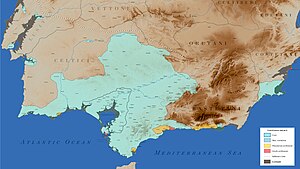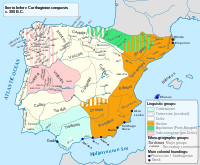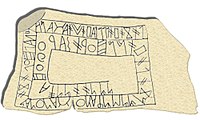Tartessos


Tartessos (Spanish: Tartesos) is, as defined by archaeological discoveries,[1] a historical civilization settled in the southern Iberian Peninsula characterized by its mixture of local Paleohispanic and Phoenician traits. It had a writing system, identified as Tartessian, that includes some 97 inscriptions in a Tartessian language.
In the historical records, Tartessos (Greek: Ταρτησσός) appears as a semi-mythical[2] harbor city and the surrounding culture on the south coast of the Iberian Peninsula (in modern Andalusia, Spain), at the mouth of the Guadalquivir. It appears in sources from Greece and the Near East starting during the first millennium BC. Herodotus, for example, describes it as beyond the Pillars of Hercules.[3] Roman authors tend to echo the earlier Greek sources, but from around the end of the millennium there are indications that the name Tartessos had fallen out of use and the city may have been lost to flooding, though several authors attempt to identify it with cities of other names in the area.[4]
The Tartessians were rich in metals. In the 4th century BC the historian
The people from Tartessos became important trading partners of the Phoenicians, whose presence in Iberia dates from the eighth century BC and who nearby built a harbor of their own, Gadir (
Location


Several early sources, such as
According to the 4th century BC
Pausanias, writing in the 2nd century AD, identified the river and gave details of the location of the city:
They say that Tartessus is a river in the land of the Iberians, running down into the sea by two mouths and that between these two mouths lies a city of the same name. The river, which is the largest in Iberia and tidal, those of a later day called Baetis and there are some who think that Tartessus was the ancient name of Carpia, a city of the Iberians.[9]
The river known in his day as the Baetis is now the Guadalquivir. Thus, Tartessos may be buried, Schulten thought, under the shifting wetlands. The river delta has gradually been blocked by a sandbar that stretches from the mouth of the Rio Tinto, near Palos de la Frontera to Almonte, the riverbank that is opposite Sanlúcar de Barrameda. The area is now protected as the Parque Nacional de Doñana.[10]
In the 1st century AD, Pliny The Elder[11] incorrectly identified the city of Carteia as the Tartessos mentioned in Greek sources while Strabo just commented[clarification needed].[12] Carteia is identified as El Rocadillo, near S. Roque, Province of Cádiz, some distance away from the Guadalquivir.[13] In the 2nd century AD, Appian thought that Karpessos (Carpia) was previously known as Tartessos.[4]
Archaeological discoveries
The discoveries published by Adolf Schulten in 1922[14] first drew attention to Tartessos and shifted its study from classical philologists and antiquarians to investigations based on archaeology,[15] though attempts at localizing a capital for what was conceived as a complicated culture in the nature of a centrally controlled kingdom ancestral to Spain were inconclusively debated. Subsequent discoveries were widely reported: in September 1923 archaeologists discovered a Phoenician necropolis in which human remains were unearthed and stones found with illegible characters. It may have been colonized by the Phoenicians for trade because of its richness in metals.[16]
A later generation turned instead to identifying and localizing "orientalizing" (eastern Mediterranean) features of the Tartessian material culture within the broader Mediterranean horizon of an "Orientalizing period" recognizable in the Aegean and Etruria.
J. M. Luzón was the first to identify Tartessos with modern
Excavation began at the Turuñuelo archeological site in Guareña in 2015. The site was declared bien de interés cultural in May 2022.[21][22]
Alluvial tin was panned in Tartessian streams from an early date. The spread of a
"Tartessic" artefacts linked with the Tartessos culture have been found, and many archaeologists now associate the "lost" city with

Elements specific to Tartessian culture are the Late Bronze Age fully evolved pattern-burnished wares and geometrically banded and patterns "Carambolo" wares, from the 9th to the 6th centuries BC; an "Early Orientalizing" phase with the first eastern Mediterranean imports, beginning about 750 BC; a "Late Orientalizing" phase with the finest bronze casting and goldsmiths' work; gray ware turned on the fast potter's wheel, local imitations of imported Phoenician red-slip wares.
Characteristic Tartessian bronzes include pear-shaped jugs, often associated in burials, with shallow dish-shaped braziers with loop handles, incense-burners with floral motifs, fibulas, both elbowed and double-spring types, and belt buckles.
No pre-colonial necropolis sites have been identified. The change from a late Bronze Age pattern of circular or oval huts scattered on a village site to rectangular houses with dry-stone foundations and plastered wattle walls took place during the 7th and 6th centuries BC, in settlements with planned layouts that succeeded one another on the same site. At Cástulo (Jaén), a mosaic of river pebbles from the end of the 6th century BC is the earliest mosaic in Western Europe.[citation needed] Most sites were inexplicably abandoned in the 5th century BC.
Tartessic occupation sites of the Late

The emergence of new archaeological finds in the city of Huelva is prompting the revision of these traditional views. Just in two adjacent lots adding up to 2,150 sq. m. between
Calibrated
The existence of foreign produce and materials together with local ones suggests that the old Huelva harbor was a major hub for the reception, manufacturing and shipping of diverse products of different and distant origin. The analysis of written sources and the products exhumed, including inscriptions and thousands of
Religion
There is very little data, but it is assumed that, like for other Mediterranean peoples, the religion was polytheistic. It is believed that Tartessians worshiped the goddess
Language


The
).Possible identification as "Tarshish" or "Atlantis"
Since the classicists of the early 20th century, biblical archaeologists often identify the place-name
In 1922, Adolf Schulten gave currency to a view of Tartessos that made it the Western, and wholly European source of the legend of Atlantis.[31] A more serious review, by W. A. Oldfather, appeared in American Journal of Philology.[32] Both Atlantis and Tartessos were believed to have been advanced societies which collapsed when their cities were lost beneath the waves; supposed further similarities with the legendary society make a connection seem feasible, though virtually nothing is known of Tartessos, not even its precise site. Other Tartessian enthusiasts imagine it as a contemporary of Atlantis, with which it might have traded[citation needed].
In 2011, a team led by Richard Freund claimed to have found strong evidence for the location in Doñana National Park based on underground and underwater surveys and the interpretation of the archaeological site Cancho Roano[33] as "memorial cities" rebuilt in Atlantis's image. [34] Spanish scientists have dismissed Freund's claims claiming that he was sensationalising their work. The anthropologist Juan Villarías-Robles, who works with the Spanish National Research Council, said "Richard Freund was a newcomer to our project and appeared to be involved in his own very controversial issue concerning King Solomon's search for ivory and gold in Tartessos, the well-documented settlement in the Doñana area established in the first millennium BC" and described his claims as 'fanciful'.[35]
See also
- Colaeus
- Atlantic Bronze Age
- South-Western Iberian Bronze
- Prehistoric Iberia
- Spanish mythology
- Turdetani
- Turduli
- Pre-Roman peoples of the Iberian Peninsula
- Cancho Roano
References
- ^ Construyendo Tarteso
- ISBN 978-1-78570-230-3.
- ^ Herodotus, The History, i. 163; iv.152.
- ^ a b c d Freeman, Phillip M. (2010). "Ancient references to Tartessos", chapter 10. IN: Cunliffe, Barry and John T. Koch (eds.), Celtic from the West: Alternative Perspectives From Archaeology, Genetics, Language And Literature.
- ^ Pausanias, Description of Greece, 6.19.1
- ^ Pausanias, Description of Greece, 6.19.2
- ISBN 978-1-84217-410-4.
- ^ Strabo. Geography. pp. Book III Chapter 2 verse 11.
- ^ Pausanias Description of Greece 6.XIX.3.
- ^ Thirty kilometers inland there still is a mining town by the name of Tarsis.
- ^ Pliny, Natural History, 3.7.
- ^ Strabo. Geography. pp. Book III Chapter 2 verse 14.
- ^ Talbert, Richard J. A. (ed.). Map-by-Map Directory to Accompany the Barrington Atlas of The Greek and Roman World (2000), p. 419. Archived 2011-07-27 at the Wayback Machine
- ^ Schulten (1922). Tartessos. Hamburg; Spanish tr. Madrid, 1924, 2nd ed. 1945).
- ^ The historiography of Tartessos is surveyed by Carlos G. Wagner, "Tartessos en la historiografía: un revisión crítica".
- New York Times, September 26, 1923, p. 3.
- ^ Luzón, J. M. (1962). "Tartessos y la ría de Huelva". Zephyrus. 13: 97–104.
- ^ Carriazo, J. M. El tesoro y las primeras excavaciones en 'El Carambolo' (Camas, Sevilla) (Excavaciones Arqueológicas en España), 1970.
- ^ Garrido, J. P. (1970). Excavaciones en la necrópolis de La Joya, E.A.E.
- S2CID 191378720.
- Europa Press. 17 September 2022.
- ^ Macías, C. (12 July 2021). "El Turuñuelo: la misteriosa escalera extremeña que podría cambiar todos los manuales". El Confidencial.
- Almeria.
- ^ Wagner, in Alvar and Blásquez 1991:104.
- ^ Essays from both points of view are found in Alvar and Blázquez, according to the review by Antonio Gilman in American Journal of Archaeology 98.2 (April 1994), pp. 369-370.
- ^ Detailed description and analysis of the objects found and sources mentioned above are surveyed in Fernando González de Canales Cerisola, Del Occidente Mítico Griego a Tarsis-Tarteso –Fuentes escritas y documentación arqueológica (2004) and F. González de Canales, L. Serrano and J. Llompart, El Emporio Fenicio-Precolonial de Huelva, ca. 900-770 a.C. (2004).
- ^ (es) Gonzalez de Canales Cerisola, F. Del Occidente Mítico Griego a Tarsis-Tarteso –Fuentes escritas y documentación arqueológica, Madrid, Biblioteca Nueva, 2004
- ^ (es) Gonzalez de Canales, F.; J. Llompart and L. Serrano. El Emporio Fenicio-Precolonial de Huelva, ca. 900-770 a.C.. Madrid, Biblioteca Nueva, 2004
- ^ Gonzalez de Canales Cerisola, F. (2014). "Tarshish-Tartessos, the Emporium Reached by Kolaios of Samos". Cahiers de l'Institut du Proche-Orient Ancien du Collège de France (CIPOA) II. Retrieved 29 February 2016.
- ^ "RELIGIÓN TARTÉSSICA". Archived from the original on 2016-02-21. Retrieved 2016-02-27.
- ^ Schulten, A. (1923). Ein Beitrage zur ältestens Geschichte des Westens (Hamburg 1922). An amused reviewer for The Journal of Hellenic Studies (43. 2, p. 206) agreed that "we are quite willing to add it to the long list of possible origins for the Atlantis legend" and that "our hearts burn within us to think of the Tartessian literature six thousand years old".
- ^ The American Journal of Philology, 44.4 (1923), pp. 368-371.
- ^ "Finding Atlantis". National Geographic Channel. Archived from the original on 7 July 2011. Retrieved 2 December 2014.
- ^ Canadians part of search for fabled city of Atlantis. In: Montreal Gazette, 3/13/11 [1][permanent dead link]
- ^ Owen, Edward (14 March 2011). "Lost city of Atlantis 'buried in Spanish wetlands'". The Telegraph. London. Retrieved 18 March 2011.
Sources
- Blazquez, J. M. A. (1968). Tartessos y Los Origenes de la Colonizacion Fenicia en Occidente. University of Salamanca. Assemblies of Punic materials found in Spain.
- Alvar, Jaime; José María Blázquez (1993). Los enigmas de Tartessos. Madrid: Catedra. Papers following a 1991 conference.
- Chocomeli, J. (1940). En busca de Tartessos, Valencia.
- Gonzalez de Canales Cerisola, F. (2004). Del Occidente Mítico Griego a Tarsis-Tarteso –Fuentes escritas y documentación arqueológica-, Biblioteca Nueva, Madrid.
- Gonzalez de Canales, F.; J. Llompart and L. Serrano (2004). El Emporio Fenicio-Precolonial de Huelva, ca. 900-770 a.C., Biblioteca Nueva, Madrid.
- Celestino S.; C. López-Ruiz (2016). Tartessos and the Phoenicians in Iberia, Oxford University Press, New York.
External links
General
- Almagro-Gorbea. "La literatura tartésica fuentes históricas e iconográficas".
- Detailed map of the Pre-Roman Peoples of Iberia (around 200 BC)
- Doñana
- Spaniards search for legendary Tartessos in a marsh
- Jewish Encyclopedia: Tarshish, a distant maritime district famed for its metalwork, considered by the contributors in 1901-1906 to be legendary; Old Testament references.
- Júdice Gamito, Teresa. (e-Keltoi 6) The Celts in Portugal.
- Tartessos in The Princeton Encyclopedia of Classical Sites.
